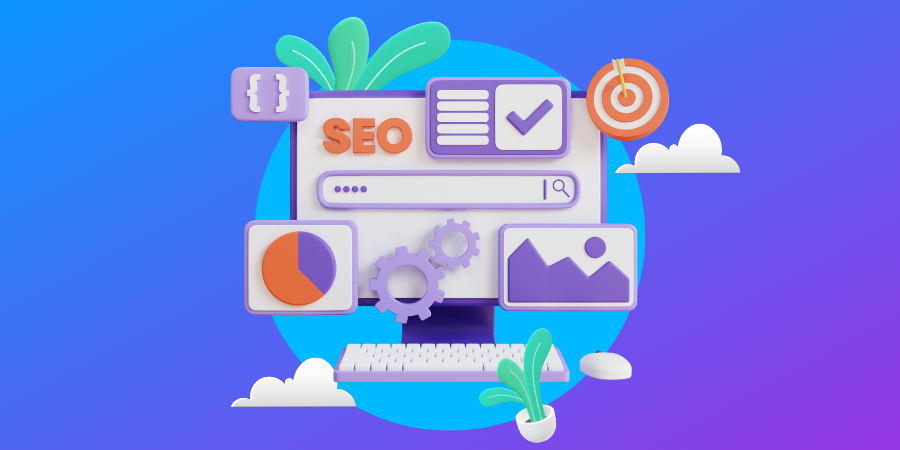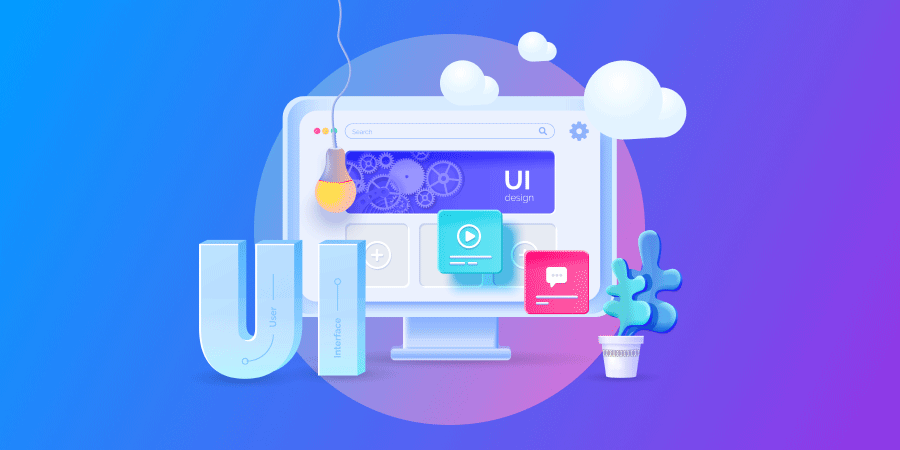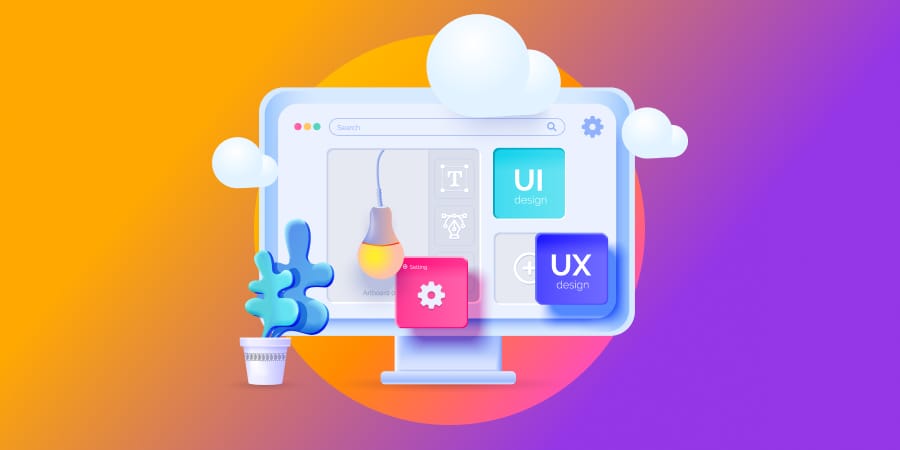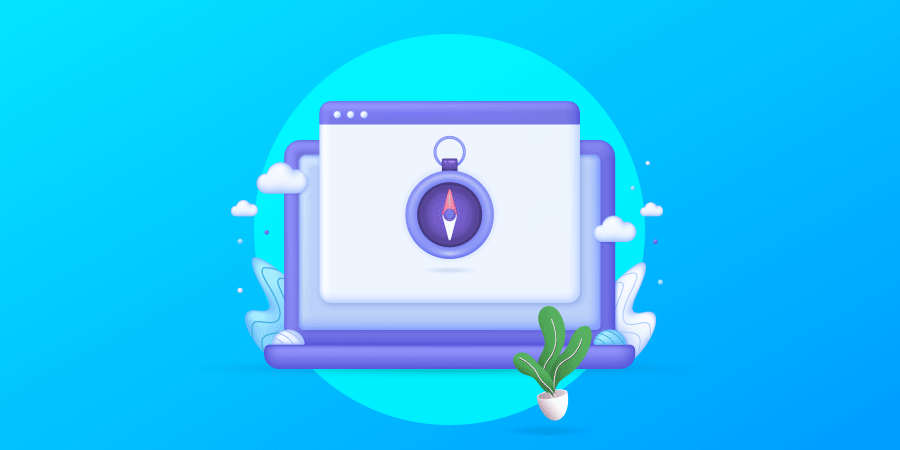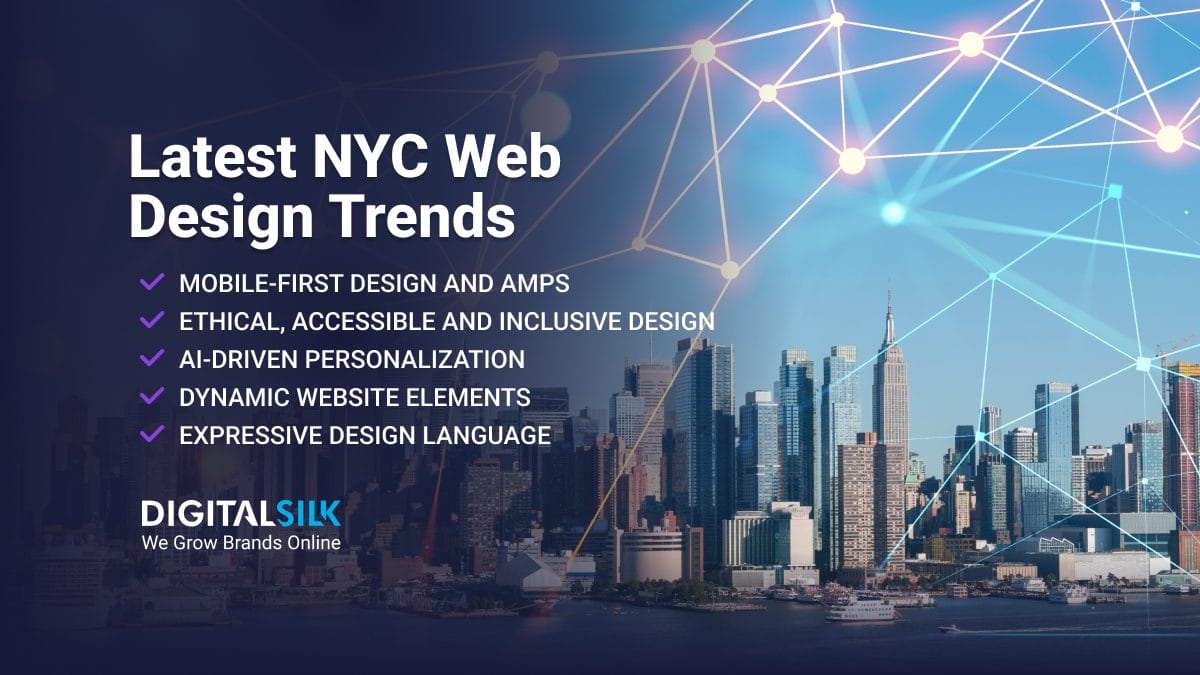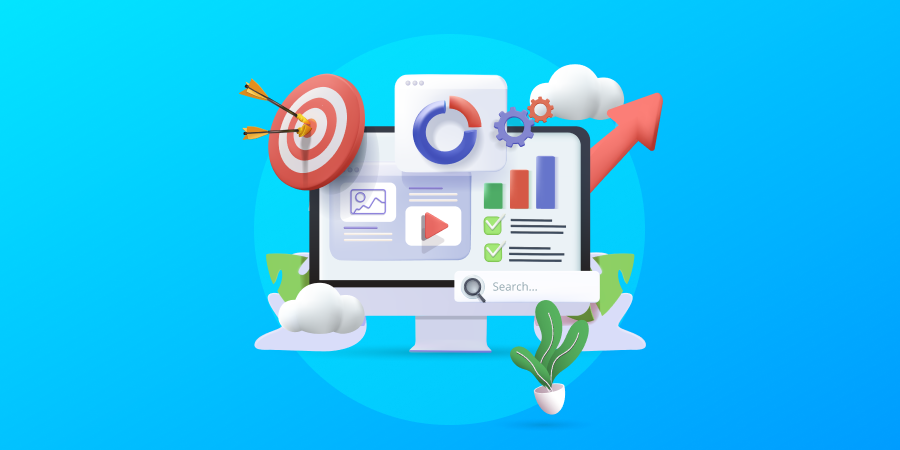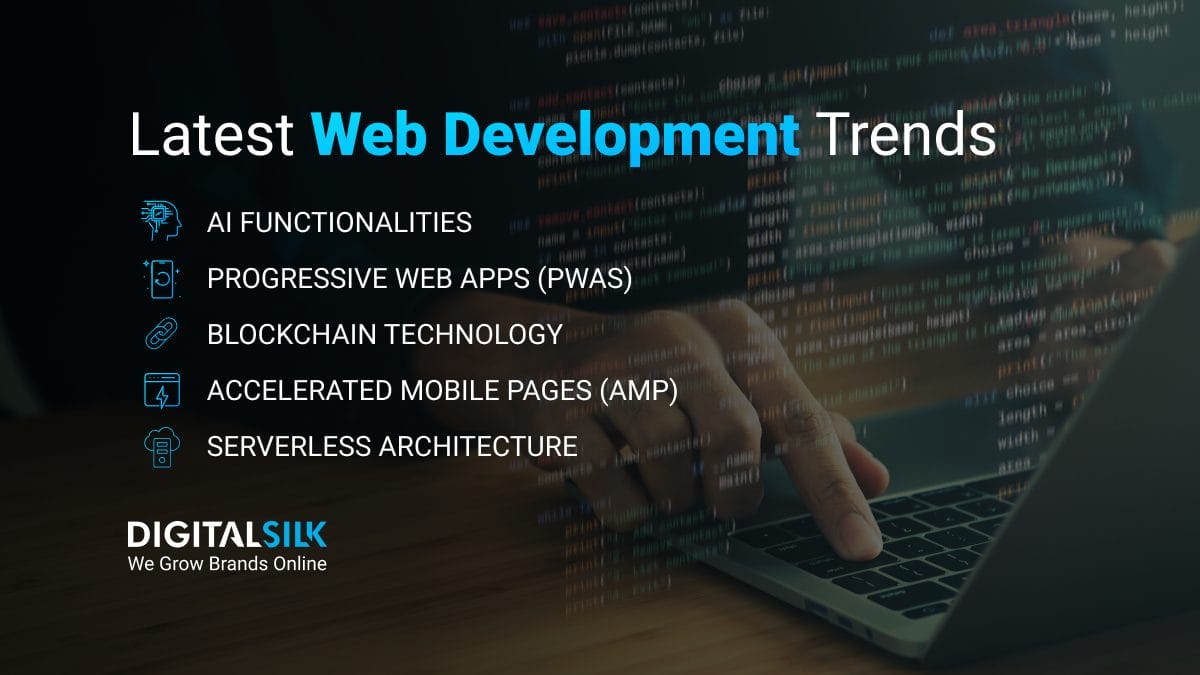There are currently more than 1.7 billion live websites and about 380 sites are launched every minute.
With so many options to choose from, your target audience can afford to be highly selective as to which sites they visit, engage with and how.
Well-defined and executed website strategies, from conversion funnel to content, can significantly improve the site’s engagement and conversion rates, as well as performance in search.
Digital Silk builds custom websites. Request a quote
Why Develop A Website Strategy?
A website strategy is a plan that helps businesses clarify the goals and KPIs for the new or redesigned website, as well as the path to reaching these.
As such it helps you:
- Define your project and create a vision for your site structure and pages
- Determine your website’s layout and core functionality
- Create a consistent design
- Develop strategic content that converts your prospects
- And more
A professional web design agency creates these strategies for each project to deliver websites that attract the client’s target audiences and optimize conversions.
Contact our experts. Set Up A Free Consultation
7 Key Website Elements Every Business Should Have
There are many components that make for a high-quality website. And with so many options out there, users can easily turn to a competitor if they are not satisfied with what they find.
Here are the top seven website elements that you should include to generate higher engagement and more conversions:
1. Contact Page
While its primary function is to allow visitors to get in touch with you, a contact page also tells them that you are a legitimate business.
This is especially important as there is a rising number of fake websites designed to trick users into providing sensitive personal details.
Besides building credibility and connecting you with prospects, contact forms help you collect the users’ emails and use them for lead nurturing via email marketing campaigns (provided they opt-in, of course).
These are the contact details that you should include on your site:
- Social media icons
- Business location
- Interactive map
- Phone number
- Email address
- Fax
Your contact page should be functional and responsive.
And to make it easily reachable and noticeable, ensure you place links both in the primary navigation and in the footer.
2. Core Products Or Services
Users visit your website for a reason. They are either interested in your content or in your products/services.
Highlight your offerings via dedicated pages or prominent sections within a one-page website.
Based on what you sell, include features, benefits, specifications and more.
These are the pages that typically generate the highest number of leads as they are designed to solve your users’ specific pain points or answer their requirements.
Make sure that these pages are optimized for search engines to reach more highly qualified leads as they search the market for the solutions that you offer.
3. Headline & Subheadline
Your page headlines will tell your visitors what you are offering as well as highlight your unique value proposition.
Good headlines are:
- Specific
- Clear
- Accurate
- Keyword optimized
Most visitors will only skim your web copy, relying on headlines and subheadlines to communicate the key points.
Make sure that each page has one headline and several well-written subheadlines.
4. CTAs
The purpose of CTAs is to make the visitors take a specific action that guides them through your website and moves them toward the bottom of the conversion funnel.
Each page of your website should have a clear purpose within the web ecosystem. As such, it features strategically created and placed CTAs to help users navigate the said ecosystem smoothly.
5. Blog
As of May 2020, over 4 million blog posts are published every day on WordPress websites only – and for a good reason.
Blogging is an effective marketing tactic that:
- Helps you rank for more targeted keywords
- Attracts more traffic via organic search
- Builds brand authority and credibility
- Helps move leads from awareness to the consideration stage
This is why 55% of marketers consider it as a top priority in their website content strategy. (HubSpot)
In the video below, you can get a more in-depth explanation as to why blogging is important for business, created by our content marketing director.
6. Success Indicators
Success indicators like awards and industry recognition make brands more credible and desirable. These provoke curiosity among visitors as well as provide reassurance in the quality of the brand’s offering.
The most common places to feature success indicator badges are:
- Homepage (use sparingly)
- Website footer
- About page
7. Navigation Menu
Invest time in your navigation menu. It will define your buyers’ journey on-site, helping them understand the high-level website structure and how to navigate through it to find the information they need.
Complex or overly discreet navigation menus cause high bounce rates which, needless to say, means a loss of lost business potential.
Focus on your target user behavior to design a menu that is intuitive as it is engaging.
The most popular types of navigation menus are:
- Interactive (“regular” header)
- Double-tier (recommended for B2B and complex sites)
- Hamburger (recommended for brands with tech-savvy user base)
- Static sidebar (mostly used by publishers)
What Is A Website Conversion Funnel?
Let’s talk conversion first; A conversion refers to any predefined and desired action on your website, be it a successfully completed purchase, newsletter signup, resource download, contact form submission or other.
A website conversion funnel refers to the steps your leads take from the point at which they first land on your website to the point where they completed this desired action, i.e. convert.
There are several stages prospects can go through:
- Discovery: To make prospects aware of your existence create landing pages, ads, videos, infographics and other resources that will educate them.
- Consideration: To make them engage, establish trust and reassure them that your product or service is a good fit for them, incorporate blog posts, case studies, reviews, emails, webinars and FAQs on your website.
- Purchase: To influence their buying decisions and make them convert, leverage email and social media marketing to offer giveaways, coupons and more.
Why should you care about your website conversion funnel?
On the one hand, knowing at what stage of the conversion journey your prospects are, you can define the types of content to put in front of them.
On the other hand, a funnel report can show you where you are losing your customers. It will tell you what you do right and what you do wrong as well as help you improve your website selling strategy.
10 Website Strategies To Boost Your Online Performance
Having a visually compelling website is one thing, but making it work and achieving your business goals is quite another.
No matter your company size or industry, an effective website should achieve the following:
- Attract qualified traffic
- Engage visitors
- Convert them
Here are some proven website strategies that will boost your online performance and get your visitors to take action:
1. Have A Clear & Compelling Value Proposition
Your value proposition can determine the potential of your conversion rate to a great extent.
It is the promise you give to make your products/services attractive.
A good value proposition solves problems and provides specific benefits your competitors can’t cover.
It is a unique identifier that tells your prospects why they should choose you over everyone else.
This is why it should be authentic and different from the other websites in your industry.
It should also be short, clear and easy to understand, as well as reflect your brand identity.
2. Include Videos
Research by HubSpot shows that 54% of consumers prefer to see video over any other type of content.
In fact, 81% of businesses say that their explainer videos have helped them generate higher sales.
This is why video should be a part of your website strategy.
Selling is storytelling. And videos are the perfect way to share a story about your products, services or company.
They keep your visitors engaged and make them stick around longer, which is great for better website performance.
In fact, dwell time is one of Google’s 200 ranking factors.
3. Improve Your Internal Linking Structure
A good internal linking structure should be part of your website strategies for two reasons:
- First, it is a great way to encourage users to engage and spend more time navigating your site. By using anchor texts in relevant and related content, you will increase the interest of your readers.
- Second, internal linking increases the number of page views, improves the time spent on the site and boosts your search engine rankings.
4. Add A Live Chat
Research shows that the average time in which customer service representatives respond to client requests is 12 hours and 10 minutes.
However, 88% of them expect to receive a response within 60 minutes.
If you fail to achieve this, you may lose a significant number of leads.
The best way to improve customer support and satisfaction is to add a live chat to your website.
With the rise of social media, web users are used to chatting so they prefer to talk with brands in real time. This is why these forms are quickly becoming the leading customer service medium.
Live chats not only reduce support costs but also increase conversions and sales.
5. Do A/B Testing
According to a study by Coppyblogger, 8 out of 10 users read headlines, but only 2 out of 10 read the body of your page.
A good headline can make or break your engagement rates, and A/B testing can help you identify the ones that work best.
This process allows you to measure the performance of different headlines. You can test for headline length, tone and even usage of numbers.
And this is just one small, yet important element A/B testing can help you improve.
With this process, you can also enhance your:
- CTAs
- Images
- Sales copy
- Fill-in form
- And more
By incorporating A/B testing in your B2C or B2B website strategies, you can improve content engagement, reduce bounce rates and increase your conversion rates.
Speak with our experts. Set Up A Free Consultation
6. Offer A Lead Magnet
Not all of your website visitors are ready to make a purchase and convert. Some of them are still at the top or in the middle of the conversion funnel.
However, offering a lead magnet or free downloadable content (like an eBook or whitepaper) is a great way to build a relationship and trust.
It helps you build authority, grow your email lists and attract people to engage.
7. Use Call To Actions (CTAs)
We’ve already covered CTAs earlier in this article, so let’s take it a step further to identify the types of CTAs that perform the best.
According to a study of 33,000 CTAs, HubSpot discovered that personalized calls to action convert 202% better.
This is why you should focus on incorporating tailored CTAs, created with your content and audience in mind.
8. Make It Responsive
Last year, mobile devices were responsible for 52.6% of the total website traffic.
As smartphones and tablets are becoming the leading source of website visitors, responsive design is of key importance for user retention.
This format enhances the users’ browsing experience and increases search engine visibility.
It contributes to faster pages, lower bounce rates and higher conversions.
9. Incorporate Social Proof
92% of buyers read at least one review before making a purchase.
The driving force behind social proof is the so-called bandwagon effect. It is a psychological concept that denotes that consumers are more likely to engage in action if others are doing it.
Social proof like case studies, testimonials and reviews ease the minds of the prospects, build trust and entice them to convert.
10. Have A Hypertext Transfer Protocol Secure (HTTPS)
Research shows every 39 seconds websites are threatened with a new hacker attack. And the best way to protect the integrity of your website is to invest in a Hypertext Transfer Protocol Secure (HTTPS).
It will keep your communication, financial details and the privacy of your users’ personal data safe.
HTTPS protocol plays a huge role in boosting visitors’ loyalty. It gives them peace of mind that they can trust your site. It decreases bounce rates and encourages users to engage and convert.
What’s more, this security extension also boosts your search engine performance since Google confirmed that it is one of the rankings signals.
How To Measure The Effectiveness Of Your Website Strategy: Key KPIs To Focus On
Key Performance Indicators (KPIs) are measurable values that track the effectiveness of your website strategies.
They demonstrate how successfully your brand is performing in relation to your business goals and objectives.
These indicators provide you with useful information on your company’s progress and play a key role in decision-making.
Since each website is different and has different goals, the KPIs that work for you may not work for another business.
So, to define your KPIs and effectively measure your website strategies, you should determine your desired outcomes.
Make sure they are specific, measurable and relevant to your business.
Here are some of the most common metrics that can help you measure your website strategies:
- Bounce rate: It refers to the percentage of single-page sessions in which users left without visiting another page. These are important to track since they can point to pages that load slowly, irrelevant content and more.
- Top landing pages: Looking at this metric, you can understand what are your best-performing pages that bring the highest traffic. It will also help you discover if your website content strategy works.
- Conversion rate: It allows you to track the number of conversions and see how well your website is doing.
- Cart abandonment (eCommerce): This metric will show you how many people place your products in their shopping carts and then leave the page without checking out.
There are many tools that can help you track these metrics. However, looking at your Google Analytics is the most trustworthy source since the results come from the search engine itself.
Takeaways On Website Strategies
Your website is one of the most effective marketing tools.
The key elements that you should include to achieve your business goals are:
- Contact page
- Core products or services
- Headlines and subheadlines
- CTAs
- Blog
- Success Indicators
- Navigation menu
For your prospects to convert successfully, experts at our web design agency develop the right content for each stage of the conversion funnel:
- Landing pages, ads, videos and infographics for the discovery phase
- Blog posts, case studies, reviews, emails, webinars and FAQs for the consideration stage
- Giveaways, special offers and coupons for the purchase phase.
To boost your online performance, focus on these website strategies:
- Have a clear and compelling value proposition
- Include videos
- Improve your internal linking structure
- Add a live chat
- Do A/B testing
- Use CTAs
- Make your website mobile responsive
- Incorporate Social Proof
- Invest in HTTPS
You can only achieve your objectives if you set the right KPIs. So, make sure they are specific, measurable and relevant to your business.
"*" indicates required fields


